Synology RackStation RS18016xs+ review
It’s big on storage, features and performance but Synology’s new rack NAS is expensive
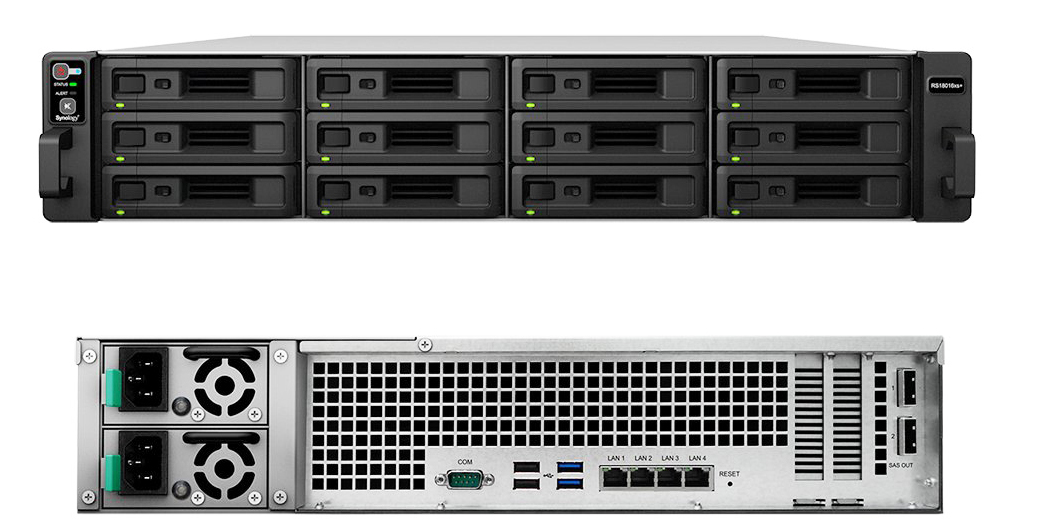
Not ideal as a storage cluster, but the RS18016xs+ is packed with features and is a good choice where having lots of storage capacity is a high priority
-
+
Huge storage capacity; Top NAS performance; SAS and SATA support; Unlimited snapshots; Surveillance Station app
-
-
Too expensive for failover duties; Flimsy drive carriers

Synology is best known for its range of consumer and prosumer NAS devices, but the Taiwanese company also has a long-standing range of rack-mountable devices aimed at businesses. The RS18016xs+ is a 2U chassis equipped with a 3.3GHz Xeon E3-1230 v2 CPU. Its 8GB of DDR3 can be expanded to 32GB and it can handle SAS and SATA drives. It also supports BTRFS and has slick data recovery features.
If you have big expansion plans then the dual SAS expansion ports will be of great interest. You can use these to add up to fourteen RX1216sas 12-bay disk shelves. With 8TB drives already certified, you can push capacity to a whopping 1.4 petabytes and extra shelves can be hot-plugged in without powering the head unit down.
Another key feature is support for Synology's failover feature which allows you to create a high availability cluster by linking up a second RS18016xs+ over a dedicated heartbeat link. A pair will set you back nearly seven grand though, making fault tolerant arrays such as Qsan's U400HA-D424 much more affordable.
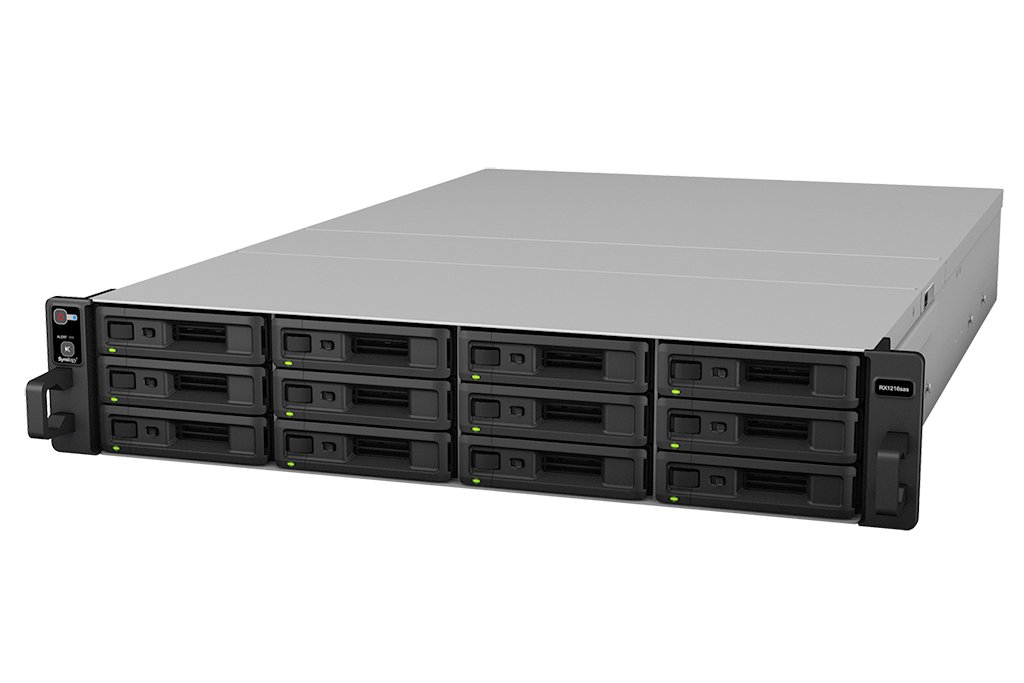
Storage capacity is huge as you can daisy-chain up to fourteen 12-bay disk shelves to the main unit
Build quality and deployment
The RS18016xs+ is solidly built and has a removable panel on the top to allow its hot-plug fans to be easily replaced in the event of a failure. Power redundancy also comes as standard as the price includes a pair of 500W hot-plug PSUs.
The drive carriers are too flimsy for our liking, though. The thin metal strips above and below the plastic handles are easily bent when inserting or removing drives and this happened to three of the carriers on our test unit.
Despite this, we found deployment easy enough using a a quartet of 4TB WD SAS drives. Synology's Web Assistant portal located the appliance on the lab network and installed Synology's latest DSM software.
On completion, we used the DSM's Storage Manager to create a RAID-5 array. A handy alternative is Synology's hybrid RAID (SHR) which allows you to mix drives of different sizes in the same array without taking a hit on capacity.
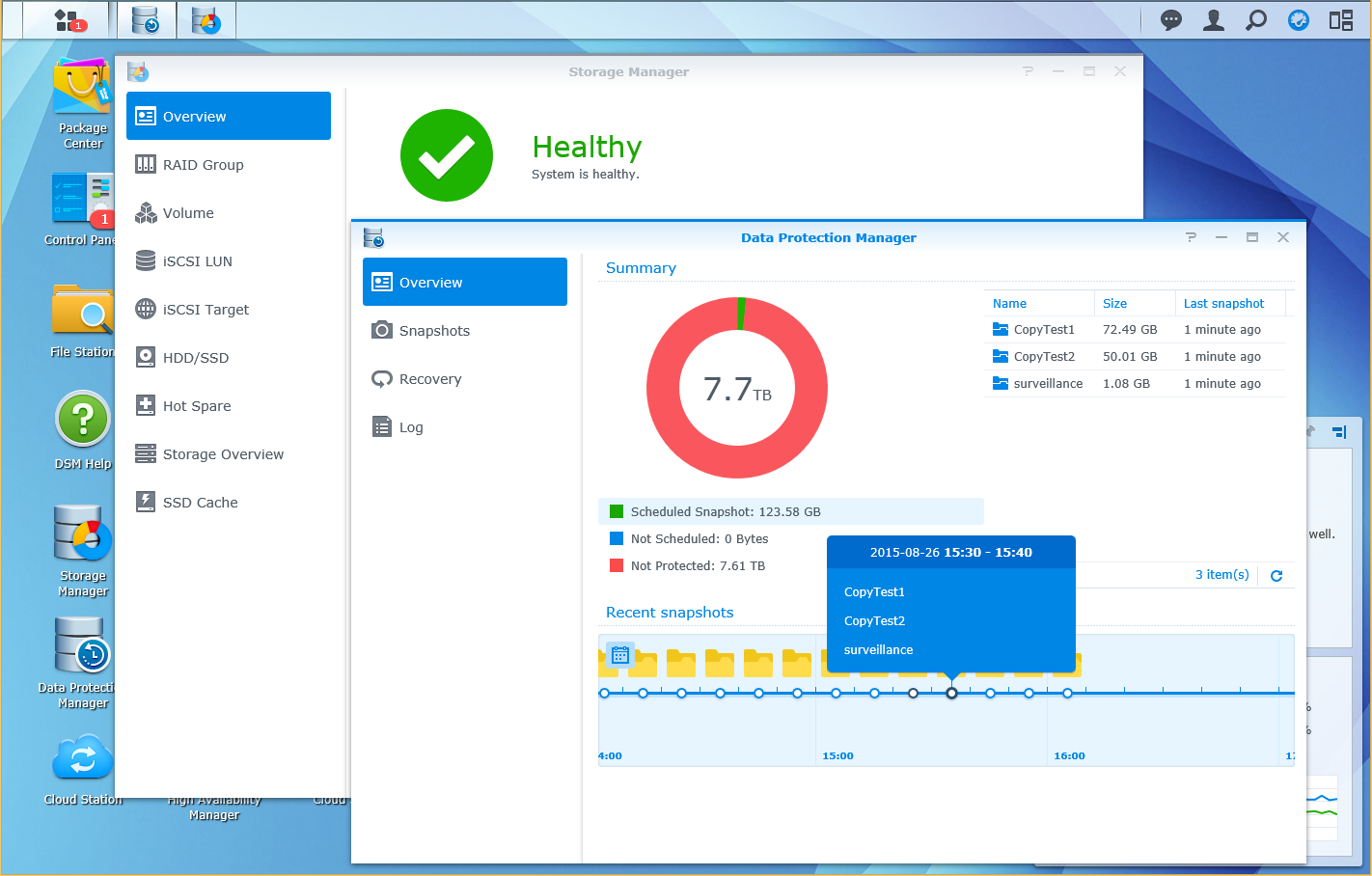
Select BTRFS during volume creation and you can create as many snapshots as you like
BTRFS and snapshots
During volume creation you can select BTRFS or EXT4 with the former enabling unlimited snapshots. These are managed from the new Data Protection Manager (DPM) app where you enable the advanced data protection feature when creating NAS shares.
Bear in mind when creating an IP SAN that snapshots are only supported for file-level iSCSI targets. If you choose block-level targets, the snapshot options in the DPM are greyed out.
Snapshots are easy to manage as we could create on-demand or scheduled snapshots for our shares and file-level targets. Snapshot recovery is very slick as complete shares and LUNs can be restored directly from the DPM app using a snapshot selected from the list.
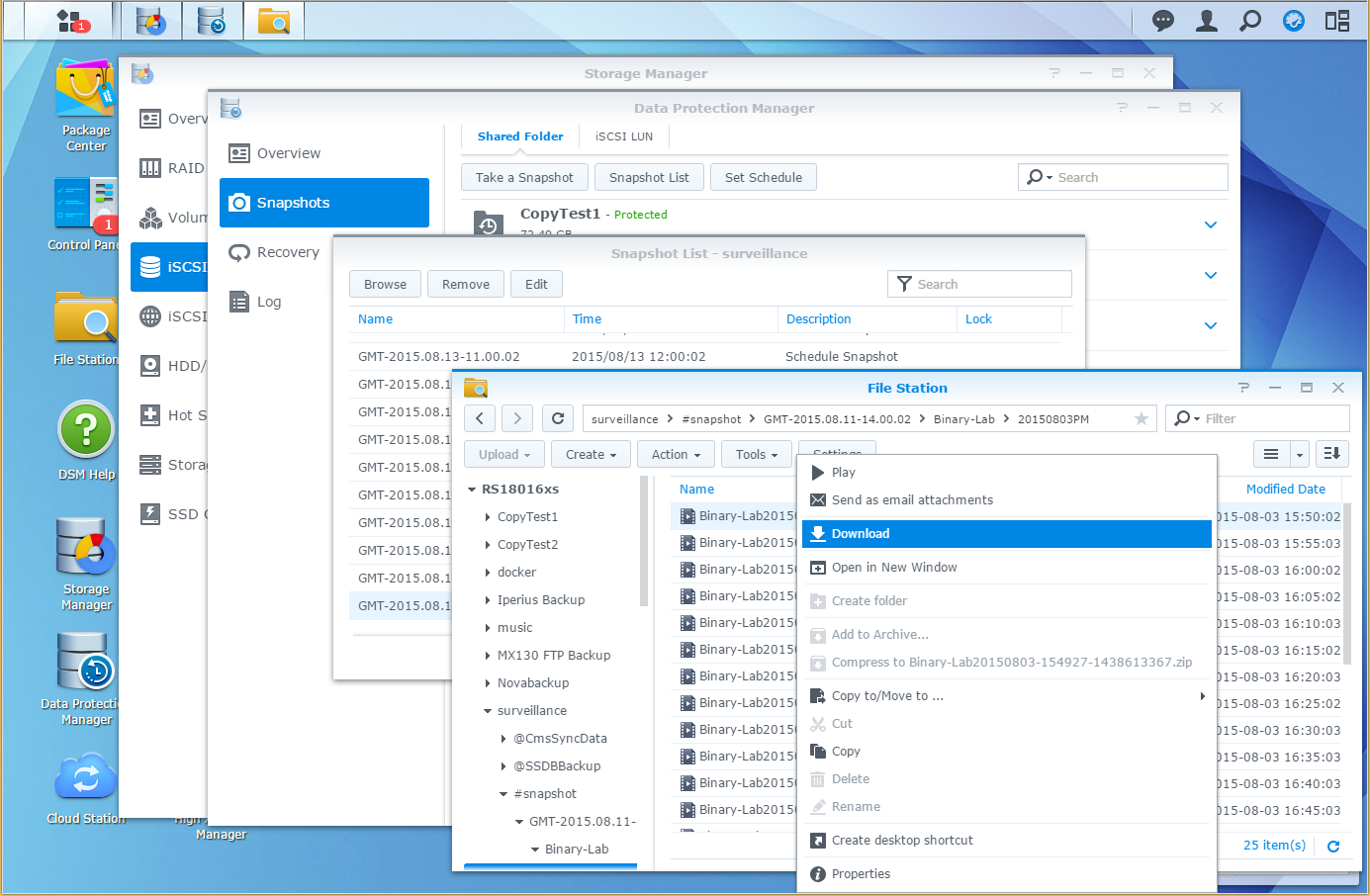
Snapshot recovery is a cinch and files can even be downloaded directly from the DSM File Manager app
Surveillance Station
The huge storage capacity of the RS18016xs+ makes it ideally suited for storing video, such as surveillance camera footage from Synology's Surveillance Station app. This software is easily the best of its type on the NAS market and we tested the 7.1 beta version which was swiftly installed from the Package Center app.
Latest features include full RTSP over HTTP support, single video files of up to 64GB plus support for over 400 new IP cameras. The search facility had no problems finding our D-Link DCS-6315 and DCS-7513 cameras and helped set them up ready for action.
From the camera settings page we could create continuous or scheduled recordings for specific hours on each day. These can also be linked up with the camera's motion detection triggers or any digital device attached to them such as a door sensor.
We used the Timeline app to select and view stored recordings while Action Rules can be used to link recording activities with events such as movement or a door opening. We also used Synology's iOS DS cam app to remotely access Surveillance Station and view all live feeds.
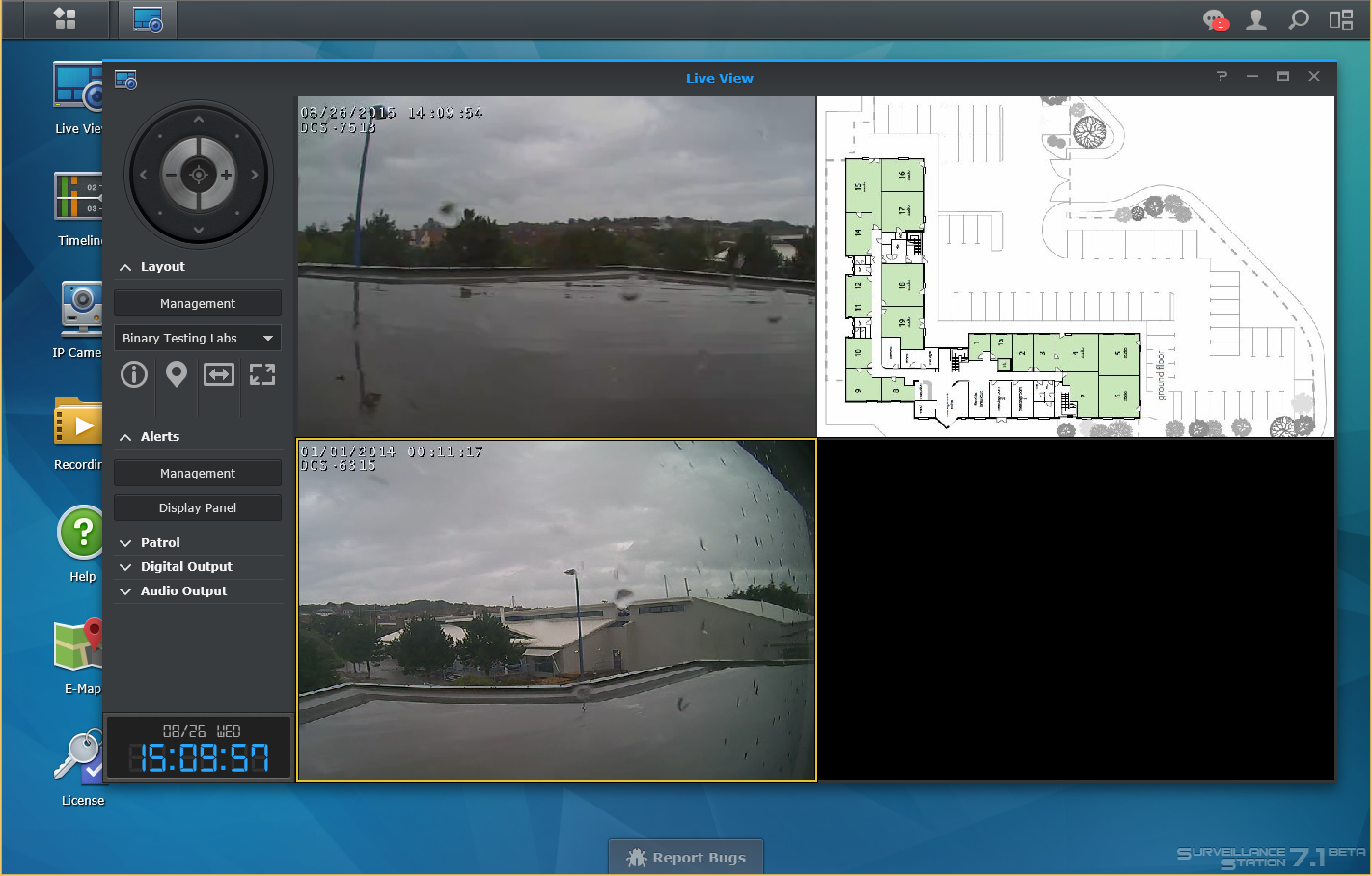
Synology's Surveillance Station won't be beaten for camera monitoring and recording features
NAS performance
For performance testing, we slotted a dual-port Emulex 10GbE card in the appliance and connected it directly to an HP ProLiant DL380 Gen9 server running Windows Server 2012 R2. With a share mapped to the server, we watched Iometer report excellent raw read and write speeds of 1,168MB/sec and 1,104MB/sec.
Real world speeds were top-notch as well with drag and drop copies of our 50GB Iometer test file recording sustained read and write speeds of 444MB/sec and 398MB/sec. To test general backup speeds, we copied a 22.4GB folder with 10,500 small files to the share which returned a good average write speed of 283MB/sec.
The E3 Xeon has an embedded AES-NI encryption engine and we tested its prowess by creating an encrypted share on the appliance. It delivered the goods - copying our 50GB Iometer file to it gave an average speed of nearly 170MB/sec.
Conclusions
We wouldn't recommend the RS18016xs+ for storage cluster duties as there are more sophisticated and better priced solutions available. It works for us as a big storage repository though, as it can be easily expanded to keep up with demand, delivers fast performance and Synology's DSM has a remarkable range of features.
Verdict
Not ideal as a storage cluster, but the RS18016xs+ is packed with features and is a good choice where having lots of storage capacity is a high priority
Chassis: 2U rack
Processor: 3.3GHz Intel Xeon E3-1230 v2
Memory: 8GB DDR3 ECC (max 32GB)
Network: 4 x Gigabit Ethernet
Expansion: 2 x SAS, 2 x PCI-Express x8 slots
Array support: RAID0, 1, 10, 5, 6, hot-spare, JBOD, SHR
Power: 2 x 500W hot-swap PSUs
Management: Web browser
Warranty: 5-year limited
Get the ITPro daily newsletter
Sign up today and you will receive a free copy of our Future Focus 2025 report - the leading guidance on AI, cybersecurity and other IT challenges as per 700+ senior executives
Dave is an IT consultant and freelance journalist specialising in hands-on reviews of computer networking products covering all market sectors from small businesses to enterprises. Founder of Binary Testing Ltd – the UK’s premier independent network testing laboratory - Dave has over 45 years of experience in the IT industry.
Dave has produced many thousands of in-depth business networking product reviews from his lab which have been reproduced globally. Writing for ITPro and its sister title, PC Pro, he covers all areas of business IT infrastructure, including servers, storage, network security, data protection, cloud, infrastructure and services.
-
 Westcon-Comstor and Vectra AI launch brace of new channel initiatives
Westcon-Comstor and Vectra AI launch brace of new channel initiativesNews Westcon-Comstor and Vectra AI have announced the launch of two new channel growth initiatives focused on the managed security service provider (MSSP) space and AWS Marketplace.
By Daniel Todd Published
-
 Third time lucky? Microsoft finally begins roll-out of controversial Recall feature
Third time lucky? Microsoft finally begins roll-out of controversial Recall featureNews The Windows Recall feature has been plagued by setbacks and backlash from security professionals
By Emma Woollacott Published
-
 The UK government wants quantum technology out of the lab and in the hands of enterprises
The UK government wants quantum technology out of the lab and in the hands of enterprisesNews The UK government has unveiled plans to invest £121 million in quantum computing projects in an effort to drive real-world applications and adoption rates.
By Emma Woollacott Published